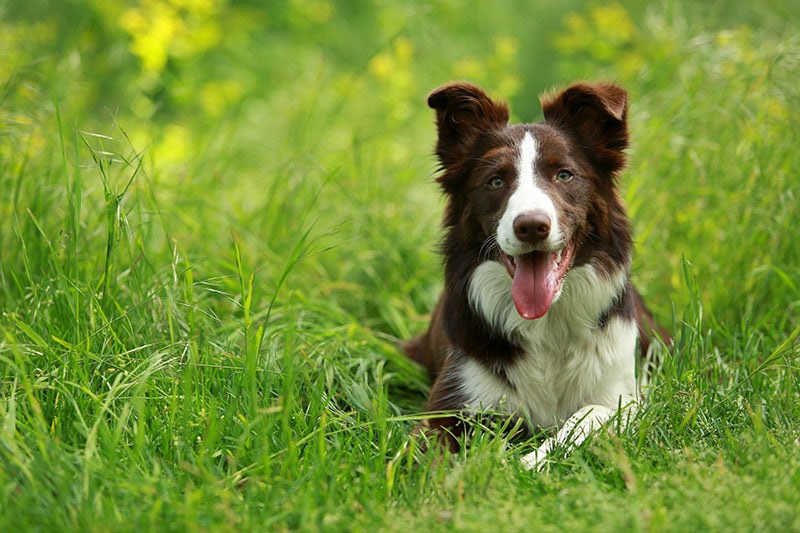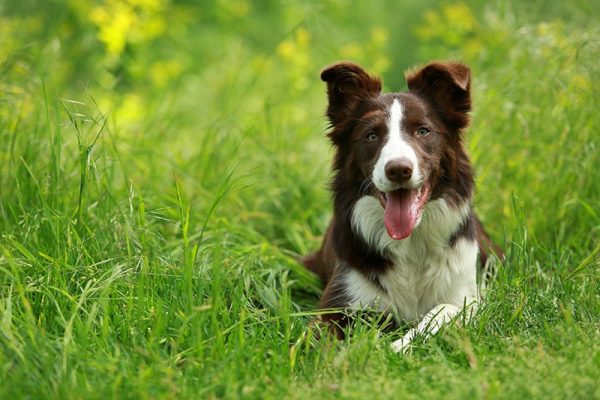Click to Skip Ahead
Border Collies come in many coat colors and patterns. You won’t find many with brown-colored coats, but certain breeders focus on them.
Brown Border Collies are not different from other members of their breed. They are equally intelligent, energetic, and hardworking. Although they are considered working dogs, they can make good pets with proper training and socialization.
Brown Border Collies are not perfect, though. There are several things every potential owner must consider before getting one. Below, we share information about the Brown Border Collie’s history and characteristics. Read on to learn unique facts about the breed and whether they are a good fit for you.
Breed Overview
Height:
18–22 inches
Weight:
30–55 pounds
Lifespan:
12–15 years
Colors:
White and brown
Suitable for:
Active families
Temperament:
Loyal, intelligent, easy to train, hardworking, protective
Most Border Collies are white and black. But the breed can also have other colors or patterns. The Brown Border Collie usually has a brown and white coat. It resembles the typical black-and-white pattern, only replacing black with brown.
Besides coat color, the Brown Border Collie mirrors its counterparts almost in all respects. For instance, it has a medium-sized double coat with a fair amount of thick fur. Its ears can be entirely dropped, semi-erect, or fully erect.
However, Brown Border Collies have unique eyes. They can be green, light to medium brown, or golden yellow.
Brown Border Collie Breed Characteristics
The Earliest Records of Brown Border Collies in History
The Brown Border Collie is a descendant of the landrace sheepdogs that once populated the British Isles. As we know it today, the breed probably originated from the Anglo-Scottish border region, where it became standardized.
Although the use of the word “Collie” began during the late 19th century, the name has roots in the Scots language. The first use of the term “Border Collie” was in 1915 when the secretary of the International Sheep Dog Society (ISDS), James Reid, used it to differentiate it from other Collies.
The Border Collie moved into other parts of the globe where sheep ranching was common during the colonial era. As early as 1858, the sheep-herding dogs had already reached New Zealand. They were also sent to Australia, Argentina, Canada, and the United States.
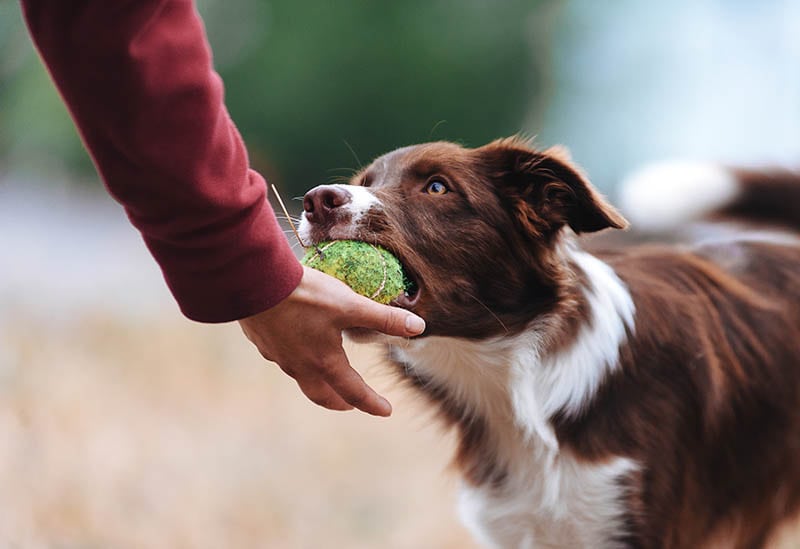
How the Brown Border Collie Gained Popularity
Interestingly, most Border Collies you will encounter today trace their origin to one ancestor—a dog named Old Hemp. His parents were Roy (black and tan) and Meg (black). Unlike most Border Collies you will find presently, Old Hemp was tricolor with a minimal amount of white fur.
Old Hemp was born in 1893 in Northumberland, England. Sheep responded to him readily. And many herders used him to sire more than 200 pups. Wiston Cap, another famous stud in the breed’s lineage, is one of his descendants.
The breed developed significantly during the 19th century when Queen Victoria became acquainted with it. She owned several Border Collies. Some of her favorites included a smooth-coated pup named Sharp and a rough-coated tricolor named Noble.
The Queen’s patronage led to widespread ownership of the breed in higher circles, transforming it into a more elegant and refined canine.
Breed clubs started sponsoring shows for the Border Collie during that period. Before that, herding trials held by the International Sheep Dog Society (ISDS) were the only popular competitions.
Registries don’t promote breeding the Border Collie for its looks. So, they accept all colors and patterns, including brown and white. Many farmers prefer the standard black and white Border Collie. However, rare colors such as brown, blue, and red have gained popularity in recent decades.
Consequently, some breeders specialize in Brown Border Collies today. Some might charge more for this rare color. But responsible AKC breeders generally frown upon that behavior.
Formal Recognition of the Brown Border Collie
The International Sheep Dog Society is the oldest Border Collie registry, founded in 1906 in England. The registry promotes the breeding of the Border Collie as a herding dog and accepts all colors, patterns, and markings, including brown.
The leading Border Collie registries in the United States are the American Border Collie Association (ABCA) and the National Border Collie Association (NBCA). Both are dedicated to preserving the Border Collie as a working dog and recognize the Brown Border Collie.
The American Kennel Club formally recognized the Border Collie in 1995. However, working registries such as the ABCA and NBCA protested. They argued the recognition by AKC would shift the focus from the breed’s working skills to its appearance.
The tension between the working registries and AKC persists. For instance, ABCA deregisters dogs who attain a conformation championship. Also, most working Registries don’t recognize AKC pedigrees and will only accept cross-registration amongst themselves.
NBCA is the only working registry that accepts registration transfers from AKC.
However, it is imperative to note that the AKC recognizes all colors, patterns, and markings. So, they also accept Brown Border Collies.
The Brown Border Collie is also recognized in other countries. They include Australia through the Australian National Kennel Council (ANKC), South Africa through the South African Sheepdog Association, and Canada through the Canadian Border Collie Association.
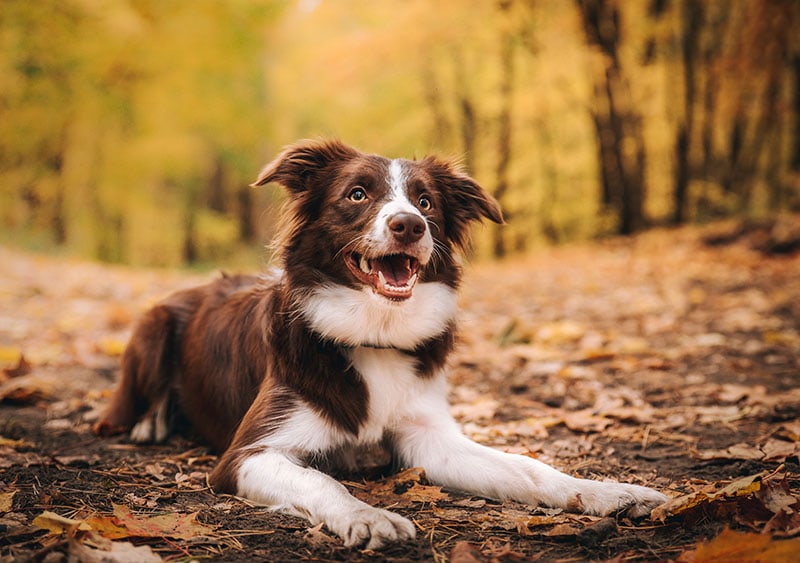
Top 4 Unique Facts About the Brown Border Collie
Here are four interesting facts about the Brown Border Collie that might interest you.
1. They Are Very Intelligent
The Border Collie is considered the most intelligent dog breed. Since color does not impact a Border Collie’s cognitive abilities, it is safe to assume that Brown Border Collies are just as smart as their counterparts.
Stanley Coren, Ph.D., author of the book “The Intelligence of Dogs,” ranked it the most intelligent dog. He used obedience tests to assess 110 breeds through the help of 200 professional dog obedience judges.
One Border Collie named Chaser dazzled the world with his intelligence. The pup was dubbed the most intelligent dog after making headlines for learning 1,022 nouns. The owner John W. Pilley trained him to understand the names of objects and comprehend complex sentences.
2. They Have Broken Several World Records
Border Collies are superior to other breeds in many respects. It is no wonder that they have broken many world records.
For example, Jumpy holds the Guinness world record for dog skateboarding. He set it after completing the 100-meter skateboard ride in less than 20 seconds.
Another Border Collie named Striker holds the record for the fastest dog to roll down a car window. It set the record in 2004 after rolling down the window in just 11.34 seconds.
Sweet Pea holds the record for the fastest 100 meters while balancing a can on the head. She did it in just 2 minutes and 55 seconds.
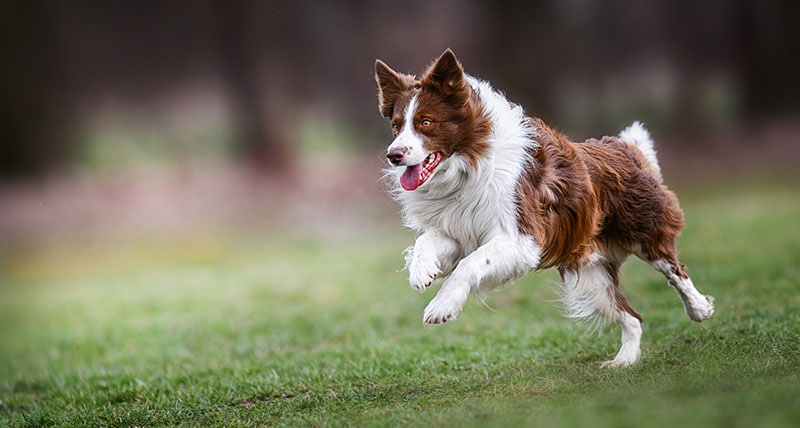
3. They May Have Originated in Rome
There is debate about the origins of the Border Collie. But the breed may likely have originated from Rome.
It is believed that guard dogs accompanied the Romans during their invasion of Britain in A.D. 43. These dogs may have later crossed with the Spitz-type dogs brought over by the Vikings who invaded Britain around 1,200 years ago.
4. They Have Acted in Films
Border Collies are not mere herders. They are also talented actors. Their intelligence and high trainability have earned them various roles as stars and extras in many films.
Some of the movies they have starred in include the 1966 Disney TV movie, “The 101 Problems of Hercules,” 1999’s “Animal Farm,” and some recent films like “John Wick” and “Man of Steel”.
Mad About You, a popular television show in the 1990s, featured a Brown Border Collie named Murray.
Does the Brown Border Collie Make a Good Pet?
The Brown Border Collie is intelligent and highly loyal, traits you would expect to find in a good pet. However, this breed is not for everyone. It can be demanding due to its high energy, thus making it more suited for an active family.
The American Border Collie Association cautions potential owners against taking on the breed if they can’t provide enough training and exercise. Due to their history as working dogs, Brown Border Collies need plenty of both to stimulate their body and minds.
If left inactive for too long, they can redirect their energy to destructive behavior such as chewing furniture or digging holes. They can also become distressed and frustrated if you ignore them for too long.
You may notice your Brown Border Collie trying to herd cats, children, and other dogs. That results from many generations of selective breeding that purposefully encouraged the trait. However, that does not mean they can’t coexist peaceably with other pets when properly trained and socialized.
Conclusion
Brown Border Collies can make good pets. They are intelligent, loyal, protective, hardworking, and easily trainable. But although those are good qualities for a pet. They can make the breed quite demanding and time-consuming.
Owners must provide intense training and exercise to stimulate the dog’s mind and body. Otherwise, the dog will become distressed and frustrated. They can also use destructive behavior to redirect their energy, including digging holes in your home or chewing your favorite couch.
If you are considering getting a Brown Border Collie, make sure you are prepared to handle the responsibility. Also, early socialization and obedience training are imperative to prevent shyness and nip problematic behaviors in the bud.
Related read:
- Tri-Color Border Collie: Facts, Origin & History (with Pictures)
- 10 Best Harnesses for Border Collies – Reviews & Top Picks
Featured Image Credit: Lioneska, Shutterstock

